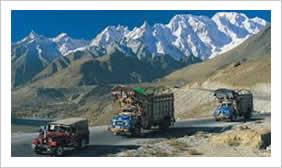The Karakoram Range
 Karakorum Range, Chinese (Pinyin) Karakorum Shan or (Wade-Giles Romanization) K’a-la-k’un-lun Shan.
Karakorum Range, Chinese (Pinyin) Karakorum Shan or (Wade-Giles Romanization) K’a-la-k’un-lun Shan.
The range is home to the highest concentration of peaks over 8000m in height to be found anywhere on earth, including K2,Broad peak,GI,GII, (K2) the second highest peak in the world 8,611 m (28,251 ft).
The range is about 500 km (311 mi) in length, and is the most heavily glaciated part of the world outside the Polar Regions. The Siachen Glacier at 70 kilometers (43 mi) and the Biafo Glacier at 63 kilometers (39 mi) rank as the world's second and third longest glaciers outside the Polar Regions. Some of the debris-covered Karakoram glaciers are found to be expanding but other ones are retreating.
The Karakoram is bounded on the northeast by the edge of the Tibetan Plateau and on the north by the Pamir Mountains. The southern boundary of the Karakoram is formed, west to east, by the Gilgit, Indus and Shyok Rivers, which separate the range from the northwestern end of the Himalaya range proper as these rivers converge southwestward towards the plains of Pakistan.
History of Karakorum:
 The ranges of this area have an old and fascinating history, one that is only completely understood when surrounded by the awesome power of the Karakoram. From Alexander the Great in 327 BC to Changhiz Khan, the Karakoram has been influenced by the experiences, traditions, beliefs, languages, and culture of some of the most powerful and legendary rulers and empires. And through this process it has become a legend of its own. Silk and species traveled from china and India to the west on the silk route, an essential route for trade in central Asia. This is now the Karakorum highway (kkh), and links Islamabad to china’s legendary city of kashgar. This road is 1300 km long and has opened up an ancient world for the curious traveler. This awe-inspiring highway, which opened in 1986, took over twenty years to complete and cost both Pakistan and china over a thousand lives in the process.
The ranges of this area have an old and fascinating history, one that is only completely understood when surrounded by the awesome power of the Karakoram. From Alexander the Great in 327 BC to Changhiz Khan, the Karakoram has been influenced by the experiences, traditions, beliefs, languages, and culture of some of the most powerful and legendary rulers and empires. And through this process it has become a legend of its own. Silk and species traveled from china and India to the west on the silk route, an essential route for trade in central Asia. This is now the Karakorum highway (kkh), and links Islamabad to china’s legendary city of kashgar. This road is 1300 km long and has opened up an ancient world for the curious traveler. This awe-inspiring highway, which opened in 1986, took over twenty years to complete and cost both Pakistan and china over a thousand lives in the process.